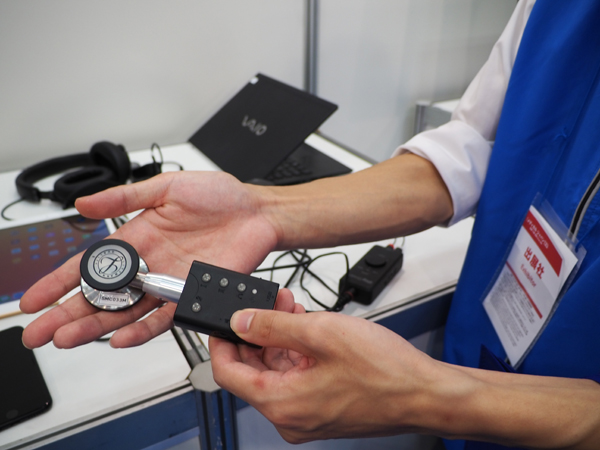Clear transmission of auscultation sounds over the internet NTT Smart Connect’s “Auditory Synchro”

NTT Smart Connect operates a service called ”Auditory Synchro” which allows remote auscultation using the Internet.
Doctors and patients are connected using the audio synchronization web conferencing function, and auscultation sounds are clearly transmitted via the Internet.
Doctors are provided with mobile devices and headphones. Nurses and patients will have mobile terminals and digital auscultation devices.
A nurse applies a stethoscope to the patient, and a doctor in a remote location listens to the patient’s heart and breathing sounds. It is also possible for a doctor to auscultate while instructing a nurse where to place the stethoscope. After auscultation, the doctor and patient communicate with each other while performing medical treatment.
The strength of this service is that by using NTT’s network, it does not leak the minute sounds that are important for medical treatment.
The frequency of heart sounds and lung sounds is said to be between 20 hertz and 60 hertz, and normal networks will muffle the sounds.
On the other hand, the network used for listening synchronization covers up to 20 hertz, so you won’t miss any important sounds.
It is already in widespread use, and Ina City, Nagano Prefecture, has introduced it as a medical MaaS medical treatment system.
Currently, the need is particularly high in the field of community medical care. It is increasingly being used in rural areas where it is becoming difficult to go to hospitals due to a shortage of doctors. For example, in Hokkaido, it is used in situations such as home-visit medical treatment.
As long as a doctor provides guidance, the person applying the stethoscope can be an amateur, so it is not impossible to apply the stethoscope yourself while receiving instructions from a doctor through a web conference.
As the shortage of doctors continues to grow in urban areas, the need will likely increase in urban areas in the future. For example, a case may be envisaged in which patients gather at a predetermined location and a doctor examines them remotely.
Another way to use the Internet is to take advantage of the features of the Internet and teach students online how to use a stethoscope and where to apply it, such as in university classes. In fact, the University of Fukui School of Medicine has introduced listening synchronization for educational purposes.
